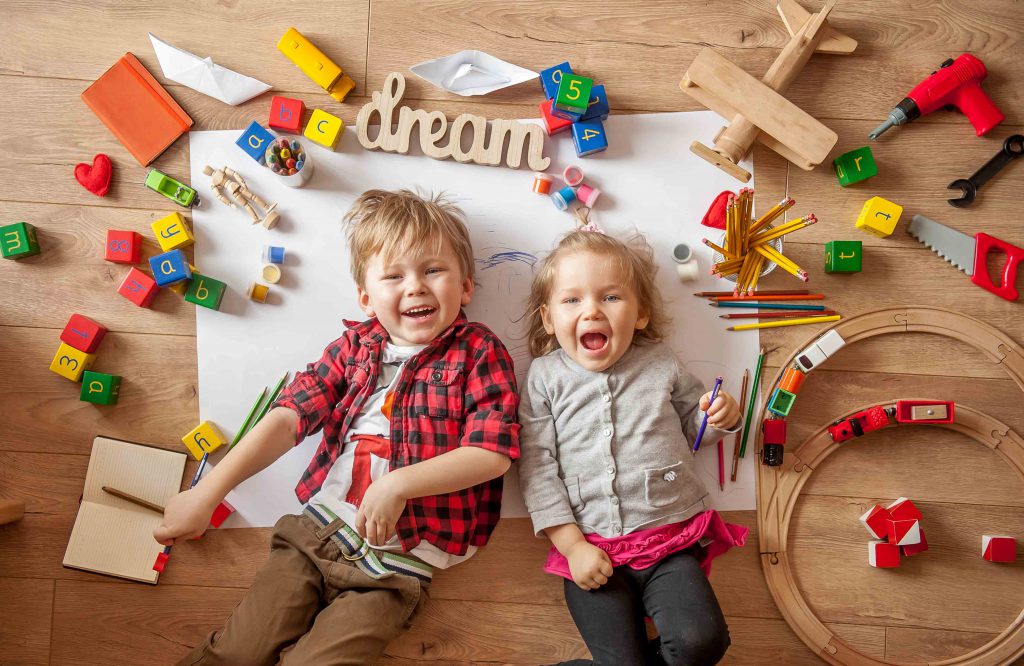You are the most interesting and important toy for your child – especially if your child is a newborn, baby, toddler or preschooler.
Making time for play with your child every day helps her learning and development – and play builds the relationship between you and your child too. You don’t have to do anything fancy – it can be as simple as singing a favourite nursery rhyme, sorting buttons by colour and shape, or having a tea party with your child and her favourite teddy bear.
Here are some more ideas for choosing toys and games to suit your child as he grows and develops. In general, it’s a good idea to keep a balance between toys that need a solution, like jigsaw puzzles, and toys that allow for open-ended play. Open-ended toys provide endless play possibilities – for example, your child might use blocks to build a tower one day, and a house the next day.
Toys and games for newborns
You’re the best ‘toy’ for your newborn. Newborns love watching your face, listening to your voice and just being with you.
Newborn play is simple. As your baby grows, she’ll enjoy looking at a brightly coloured mobile, listening to a wind-up musical toy or learning to reach for a rattle.
Toys with contrasting colours like red, black and white are most interesting to newborns. Your baby will also enjoy toys with faces or with patterns like curves or checks.
Keep in mind that newborns can’t focus on objects more than about 30 cm from their faces, so things might need to be quite close to your baby for him to see them clearly.
Newborns also enjoy nursery rhymes and songs, especially ones with actions – for example, ‘Round and Round the Garden’ or ‘Twinkle, Twinkle Little Star’.
If your baby looks tired or overwhelmed when you’re playing together, it’s time to take a break. It’s only play if she’s enjoying herself.
Toys and games for babies and toddlers
Your baby or toddler will probably enjoy playing with push-along toys, soft balls, cuddly teddies, board or cloth books that can’t be ripped, toy cars, simple puzzles and ride-on toys. Blocks are also likely to be a favourite – especially building them up and knocking them down again!
Surprise toys like a jack-in-the-box and other cause-and-effect toys are fun from around 10 months on. The initial surprise might upset some children, so introduce these toys gently.
Creative, crafty toys and games are good too – you could give your child crayons, finger paint and butchers paper. Make-believe play with hand puppets or dress-ups will also be popular.
Reading with babies and reading with toddlers is one of the most enjoyable things you can do. Try books with bright illustrations and fun rhymes.
Your pots-and-pans or plastics cupboard can be a great source of entertainment for your young child, as can many other ordinary things around your home. Remember to check for sharp edges, choking risks and other hazards before you give your child household bits and pieces to play with.
Outdoor play – for example, in the sandpit with a bucket and spade, or in the park rolling and kicking a ball – will also be lots of fun for your baby or toddler.
Children love playing with water. In the bath, your child will enjoy playing with just about anything – boats, toy fish, plastic books and coloured foam shapes. Measuring cups and empty plastic containers are fun for splashing, pouring, tipping and floating. A paddling pool will be hugely popular in warm weather.
Toys and games for preschoolers
Your preschooler is likely to enjoy anything that can be used for play-acting, like a toy tool box, old mobile phone or dress-up clothes. Your child’s imagination can turn cardboard boxes into lots of things, including a toy stove, letter box, car or boat.
You can make musical instruments with household objects – for example, plastic jars filled with rice or pasta can be used as shakers. Unbreakable bowls turned upside down become drums when your preschooler has a wooden spoon to bang with.
Quiet play activities are good for when your child needs some downtime. Try art activities like paints, crayons, pencils or cutting and pasting. Books and stories, simple board games and puzzles or construction toys are good for these times too.
Outdoor equipment – like a tricycle, cubbyhouse, sandpit or swings (with an adult nearby) – will keep your preschooler busy and active. Balls are fun to throw, hit or kick.
Toys and games for school-age kids
Your school-age child will probably have a clear idea of what he wants to play with. At this age, you can often be guided by your child’s requests or his particular interests.
Even if your child is keen on the latest techno-toy with all the electronic bells and whistles, classic and basic toys will always be popular. These include board games, books, art supplies, construction sets, jigsaw puzzles and outdoor toys like balls, cricket sets, bikes, skipping ropes and so on.
Technology – like appropriate computer games, CDs and DVDs – are also popular with this age group. But a healthy family lifestyle includes limits on daily screen time.
Your school-age child still benefits from spending time playing with you too. It can be fun to just kick a ball around together after school, or to play a card game before bath time.
